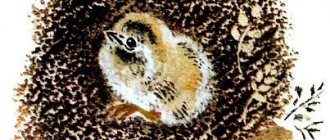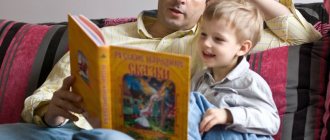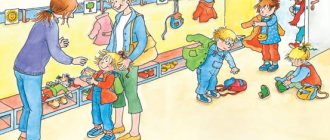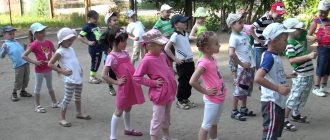Junior group. Early childhood, nursery. Children 1-4 years old
The role of folk tales in the education of young children Folk tales are one of the first literary works that adults introduce children . Works of oral folk art have a special syllable and rhythm. Children perceive fairy tales and love to listen to them many times. Fairy tales are suitable for young children ...
A comprehensive lesson on speech development in the second group of early age “Acquaintance with the Russian folk tale “Turnip”
Goal: read the Russian folk tale “Turnip” to children, introduce them to its characters. Arouse positive emotions from reading. Talk about friendship and interaction, teach how to act together. Fix the names of colors and shapes . Objectives: To develop children's thinking , to activate...
Sample list of reading materials for children in the second junior group
Lydia Podolskaya
Sample list of reading materials for children in the second junior group
Russian folklore
Songs, nursery rhymes, chants. "Finger boy."
,
“Bunny, dance.”
,
"Night has come."
, “Soroka, magpie.”,
“I’m going, going to see my grandmother, my grandfather.”
,
“Tili-bom!
Tili-bom." ;
“Like our cat.”
,
“A squirrel is sitting on a cart.”
,
“Ay, kachi-kachi-kachi”
,
“We lived with grandma.”
,
“Chicky-chicky-chickalochka.”
,
“Little kitty-murysenka.”
,
"Zarya-Zaryanitsa."
;
“Weed ant.
,." ,
“There are three chickens outside.”
,
“Shadow, shadow, shadow.”
,
"Rock-hen."
,
“Rain, rain, more.”
,
"Ladybug.
, " ,
"Rainbow-arc."
.
Fairy tales. "Kolobok"
, arr.
K. Ushinsky; “The Wolf and the Little Goats”
, arr.
A. N. Tolstoy; “Cat, rooster and fox”
, arr.
M. Bogolyubskaya; "Swan geese"
;
"The Snow Maiden and the Fox"
;
“Goby - black barrel, white hooves”
, arr.
M. Bulatova; "The Fox and the Hare"
, arr.
V. Dahl; “Fear has big eyes”
, arr.
M. Serova; "Teremok"
, arr. E. Charushina.
Folklore of the peoples of the world
Songs. "Ship"
,
“The Brave Men”
,
“Little Fairies”
,
“The Three Trappers”
English, arr.
S. Marshak; "What a Rumble"
, trans.
from Latvian S. Marshak; "Buy a bow."
, trans.
with scotch N. Tokmakova; “Conversation of Frogs”
,
“Uncooperative Hoopoe”
,
“Help!”
lane from Czech S. Marshak.
Fairy tales. "Mitten"
,
“Goat-dereza”
in Ukrainian, arr.
E. Blaginina; “Two Greedy Little Bears”
, Hungarian, arr.
A. Krasnova and V. Vazhdaeva; “Stubborn goats”
, Uzbek, arr.
Sh. Sagdully; “Visiting the Sun”
, trans., from Slovak.
S. Mogilevskaya and L. Zorina; "Nanny Fox"
, trans.
from Finnish E. Soini; “The Brave Well Done”
, trans.
from Bulgarian L. Gribova; “Pykh”
, Belarusian, arr.
N. Myalika; “The forest bear and the naughty mouse”
, Latvian, arr.
Y. Vanaga, per. L. Voronkova; "The Rooster and the Fox"
, trans.
with scotch M, Klyagina-Kondratieva; "The Pig and the Kite"
, a fairy tale of the peoples of Mozambique, trans. from Portugal Yu. Chubkova.
Works of poets and writers of Russia
Poetry. K. Balmont. "Autumn"
;
A. Blok. "Bunny"
;
A. Koltsov. "The winds are blowing."
(from the poem
“Russian Song”
);
A. Pleshcheev. "Autumn has come."
,
“Spring” (abbr.)
;
A. Maikov. “Lullaby”
,
“The swallow has rushed .” (from modern Greek songs)
;
Ah, Pushkin. “Wind, wind!
You are powerful." ,
“Our light, sunshine!”
,
"Month, month."
(from
“The Tale of the Dead Princess and the Seven Knights”
);
S. Cherny. “The Preacher”
,
“About Katyusha”
;
S. Marshak. “Zoo”
,
“Giraffe”
,
“Zebras”
,
“Polar Bears”
Ostrich”
,
“Penguin”
,
“ Camel”
,
“Where the Sparrow Dined”
(from the series
“Children in a Cage”
);
“A Quiet Tale”
,
“The Tale of a Smart Mouse”
;
K. Chukovsky. “Confusion”
,
“Stolen Sun”
,
“Moidodyr”
,
,
“Hedgehogs Laugh”
,
“Christmas Tree”
,
Aibolit
” , “Miracle Tree”
,
“Turtle”
;
S. Grodetsky, “Who is this?”
;
V. Berestov. “Hen with Chicks”
,
“Bull”
;
N. Zabolotsky. “How the mice fought with the cat”
;
V. Mayakovsky. "What is good and what is bad?"
,
“Every page is either an elephant or a lioness”
;
K. Balmont, “Mosquitoes-Makariki”
;
P. Kosyakov. "She's All"
;
A. Barto, P. Barto. "Dirty girl"
;
S. Mikhalkov. "Song of Friends"
;
E. Moshkovskaya. "Greedy"
;
I. Tokmakova. "Bear"
.
Prose. K. Ushinsky. "Cockerel with his family"
,
“Ducks”
,
“Vaska”
,
“Fox-Patrikeevna”
; T.
Alexandrova. "Burik the Bear"
;
B. Zhitkov. “How we went to the zoo”
,
“How we arrived at the zoo”
,
“Zebra”
,
“Elephants”
,
“How the elephant bathed”
(from the book
“What I Saw”
);
M. Zoshchenko. -Smart bird”; G. Tsyferov. “About Friends”
,
“When There Are Not Enough Toys”
from the book
“About the Chicken, the Sun and the Little Bear”
);
K. Chukovsky. “So and not so”
;
D. Mamin-Sibiryak. “The Tale of the Brave Hare - long ears, slanting eyes, short tail”
;
L. Voronkova. “Masha the Confused”
,
“It’s Snowing”
(from the book
“It’s Snowing”
);
N. Nosov “Steps”
;
D, Kharms. "Brave Hedgehog"
;
L. Tolstoy. "The bird made a nest."
;
“Tanya knew the letters.”
;
“Varya had a siskin.”
,
"Spring came."
;
V. Bianchi. "Bathing bear cubs"
;
Yu. Dmitriev. "Blue hut"
;
S. Prokofiev. “Masha and Oika”
,
“When you can cry”
,
“The Tale of an ill-mannered mouse”
(from the book
“Fairy Tale Machines”
);
V. Suteev. "Three kittens"
;
A. N. Tolstoy. "Hedgehog"
,
"Fox"
,
"Cockerels"
.
Works of poets and writers from different countries
Poetry. E. Vieru. "Hedgehog and Drum"
, trans.
with mold. Y. Akima; P. Voronko. "The Sly Hedgehog"
, trans.
from Ukrainian S. Marshak; L. Mileva. “Swift Legs and Gray Clothes”
, trans.
from Bulgarian M. Marinova; A. Milne. "The Three Little Foxes"
, trans.
from English N. Slepakova; N. Scored. "Pencil"
, trans.
from Ukrainian 3. Alexandrova; S. Kapugikyan. “Who Will Drink Sooner”
,
“Masha Doesn’t Cry”
trans.
from Armenian T. Spendiarova; A. Bosev. "Rain"
, trans.
from Bulgarian I. Maznina; “The Finch Sings”
, trans.
from Bulgarian I. Tokmakova; M. Karem. "My cat"
, trans. from French M. Kudinova.
Prose. D. Bisset. "Frog in the Mirror"
, translation, from English.
N. Shereshevskaya; L. Muur. "Little Raccoon and the One Who Sits in the Pond"
, trans.
from English O. Obraztsova; Ch. Yancharsky. “Games”
,
“Scooter”
(from the book
“The Adventures of Mishka Ushastik”
, translated from Polish by V. Prikhodko; E. Bekhlerova.
“Cabbage Leaf”
, translated from Polish by G. Lukin; A. Bosev.
“Three”
, translated from Bulgarian by V. Viktorova; B. Potter.
“Ukhti-Tukhti”
, translated from English by O. Obraztsova; J. Capek.
“A Hard Day”
,
“Into the Forest”
,
“Yarinka’s Doll”
(from the book
"The Adventures of a Dog and a Cat"
, translated by Czech G. Lukin; O. Alfaro.
"The Goat Hero"
, translated from Spanish by T. Davityants; O. Panku-Yash.
"Good night, Dooku!"
, translated . from the Romanians by M. Olsufieva,
“Not only in kindergarten”
(abbr., translated from the Romanians by T. Ivanova.
Sample list for learning by heart
"Finger boy."
,
“Like our cat.”
,
“Cucumber, cucumber.”
,
“The mice dance in circles.
,." , russian
adv. songs; A. Barto. “Bear”
,
“Ball”
,
“Boat”
;
V. Berestov. "Cockerels"
;
K. Chukovsky. “Christmas tree” (abbr.)
;
E. Ilyina. “Our Christmas tree” (abbr.)
;
A. Pleshcheev. "Rural Song"
;
N. Sakonskaya. “Where is my finger?”
.
STORYTALKING AND READING TO CHILDREN
The program list of works for storytelling and reading to children of the third year of life includes folk tales and nursery rhymes, works by Soviet writers and short stories by Russian classics. This type of work with children is allocated approximately 4-5 lessons per month.
Fairy tales. Over the course of the year, children are introduced to approximately five Russian folk tales. It is easier for a small child to perceive a story than reading, so storytelling in the first younger group is preferable. It requires careful preparation from the teacher. Usually in class a fairy tale is told twice, sometimes repeated a third time. This does not bother the children, since the teacher ensures their activity while listening: he offers to perform imitation movements (the kids show how big the turnip was; how they pull and pull it, etc.), uses a variety of visual aids (showing tabletop theater figures is replaced by showing pictures on a flannelograph, etc.), encourages you to stage or dramatize an excerpt from a fairy tale.
The greatest completeness of perception is achieved when the teacher combines his story with the display of figures from a tabletop theater, and when telling the story again, he either operates with the same figures or resorts to staging a fairy tale (both with the help of a flannelograph and using “Living Pictures”). It is most convenient to work with tabletop theater figures: showing them does not take much time and does not interfere with the smoothness of the presentation. The use of visual materials during the lesson activates children's attention, ensuring its focus, and also promotes the child's recall of the text of the fairy tale during subsequent independent play with familiar figures.
It is known that in the third year of life, a child can listen to an adult’s story, not accompanied by a demonstration (of toys, actions, play situations). To what extent can this be used in storytelling classes?
Storytelling without visual accompaniment is advisable for classes devoted to repeating fairy tales familiar to children.
In this case, after the first telling of the text, the teacher helps the children remember the content of the fairy tale through tasks that simultaneously help the kids change their position and move (show how they pulled a turnip; jump like frogs, etc.). Here the passages that are most interesting in terms of enriching speech are recalled (reproduced) (“the mouse ran and touched its tail”; “the little house crackled, fell on its side and completely fell apart”; “little goats, open up, open up!”). You can offer kids a task that requires them to perform more complex mental operations. For example, ask to tell about who pulled the turnip (in front of the children there are figures of all the characters from the fairy tale), but not in the traditional presentation, but in the reverse order: mouse for... cat, cat for... Bug... etc.
It is also necessary to provide tasks for the formation of intonation expressiveness of speech.
The perception of some fairy tales, for example the Russian folk tale "Kolobok", is more successful if preliminary preparation is carried out. 1-2 days before the lesson, children look at the illustrations for the fairy tale (preferably done by Yu. Vasnetsov or E. Rachev), and read the kolobok song to them. Or before telling the fairy tale “The Little Goats and the Wolf,” the teacher shows illustrations and characterizes the characters: “The little kids are small, the wolf is big, very scary.” Children learn and remember that the goat went “to eat silk grass and drink cold water.” And only then the teacher offers to listen to a fairy tale “about a goat, smart and obedient little kids and a scary, big, bad wolf.”
It is advisable to end the lesson with children playing independently with tabletop theater figures, as well as looking at the illustrations. Kids remember the words that one or another character says in a fairy tale; The teacher encourages attempts at dramatization and staging.
One of the lessons can be devoted to repeating a fairy tale that was recently told to children, and a fairy tale that the kids were introduced to a month and a half ago (for example, “Turnip” and “Rocktail Hen”).
When repeating a fairy tale with children, it is not always necessary to tell it in its entirety. In some cases, it is enough to recall individual passages, in particular those that are easier to forget or are most interesting in terms of enriching speech. The teacher begins to tell the passage alone, and continues together with the children. Here, tasks to develop intonation expressiveness of speech are required. Let’s give an example: “Now grandma and grandpa are pulling a turnip. Who will they call for help? - the teacher thinks. “They’ll call their granddaughter,” the children prompt. “For some reason there is no granddaughter. She probably ran far away. Let’s help grandfather and grandmother call her,” says the teacher. “Granddaughter, go pull the turnip!” - the children call (choral and individual statements). Or, consoling a grandfather and grandmother who have lost a golden egg, children practice exclamatory intonation (“Don’t cry, grandfather!”).
When repeating fairy tales, it is advisable to introduce elements of dramatization. This brings the kids a lot of joy. And although often, having willingly taken on this or that role, the child forgets it and does not always coordinate his actions with the actions of his partner, the teacher should not be embarrassed by these difficulties. The teacher must remember that such exercises require great tact, patience and more frequent approval of the children’s actions and evaluation of their speech (both the content side and the emotional side).
Nursery rhymes. In the first junior group, very serious attention is paid to familiarizing children with nursery rhymes. In this manual, a lot of space is devoted to this issue, since this type of activity often makes it difficult for the teacher (if necessary, the teacher can replace the nursery rhymes given in our book with others that are more accessible to his students, or read the most difficult nursery rhymes to the kids in the summer months).
Getting to know each new nursery rhyme brings joy to the kids. They listen with pleasure to the sound of folk speech, catch the poetic rhythm, the richness of the shades of words: ant grass, ant grass, tit bird, etc. Reading itself creates favorable conditions for emotional contact with children. They become quiet, smile, ask
The role of fairy tales in the development of children of the second younger group
At primary school age, the child begins to develop comprehensively. It is at this age that many psychological processes actively develop in children:
- imagination
- speech
- memory
- thinking
In addition, during this period the formation of the child’s personal qualities continues. At the age of 3-4 years, children require special attention from parents and teachers; during the educational process, educators should pay attention to the use of various approaches, methods and means of teaching and education.
In modern society, the most acute problem is the social health of children and adolescents. You should pay attention to the social health of children from early preschool age. Already from the age of 3-4 years, it is necessary to lay the foundations of spirituality and culture for children, to instill in them highly moral and ethical qualities.
Are you an expert in this subject area? We invite you to become the author of the Directory Working Conditions
One of the most effective tools in this work is fiction. A variety of fairy tales, poems, and stories resonate in the hearts of children.
Hygienic aspects
Reading the work “Moidodyr” in the 2nd junior group is aimed not only at introducing preschoolers to poetry. Together with the children, the teacher highlights the basics of a healthy lifestyle and develops hygiene skills in their students. This work can be considered a reference book for the first acquaintance with human hygiene. Reading the work “Moidodyr” in the 2nd junior group can be done in the form of a puppet theater, so that the children not only hear, but also see how to wash themselves so as not to be sloppy people.
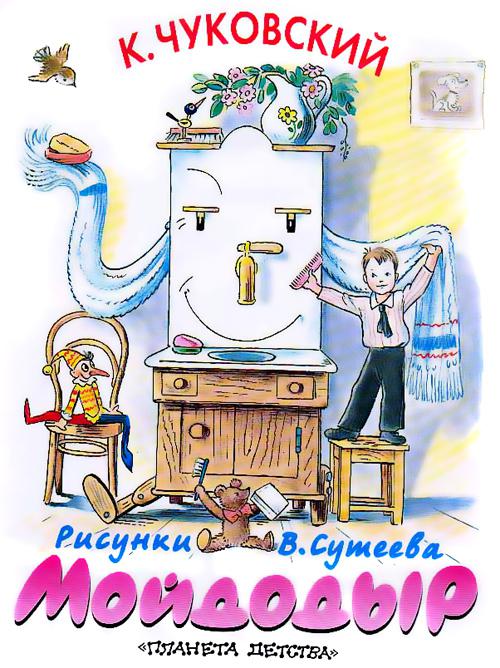
Winter audio tales
- Winter hut of animals
- Twelve months
- "Moroz Ivanovich"
- Why are snowflakes different?
- "Train from Kurolesye"
- "Sampo and the Mountain King". "Winter strawberries" "Moroz Ivanovich"
- "Silver Hoof"
- "Snow Maiden"
Winter Tales by Lyudmila Vasilyeva-Gangnus
- "The Tale of the Unmelting Snowflake"
- "About the Snow Woman"
- "About the Snow Maiden"
- "About the Little Penguin"
- "Ice Watch"
- “How Frost sewed his own fur coat”
The benefits of reading fiction for children 3–4 years old
In children aged 3–4 years, there is an active development of imagination and cognitive processes. The child is already able to emotionally evaluate and comprehend the texts of works: empathize with the characters, give an assessment, and draw conclusions.
Reading fiction develops imaginative thinking, fosters a love of reading, nature, and the world around us. Collective reading in a group helps the teacher to open up for children the world of relationships between people, the features of life in society.

Reading fiction develops imaginative thinking
Reading books is the path along which a skillful, intelligent, thinking teacher finds the way to a child’s heart.
V.A. Sukhomlinsky
The following goals for reading classes in the second junior group are set:
- developing a complete picture of the world;
- development of speaking skills;
- continued acquaintance with the artistic word;
- developing the ability to construct answers to questions;
- development of perception of artistic images;
- introduction to the culture of reading, the formation of a love for books;
- development of emotional reaction to events in works of art.
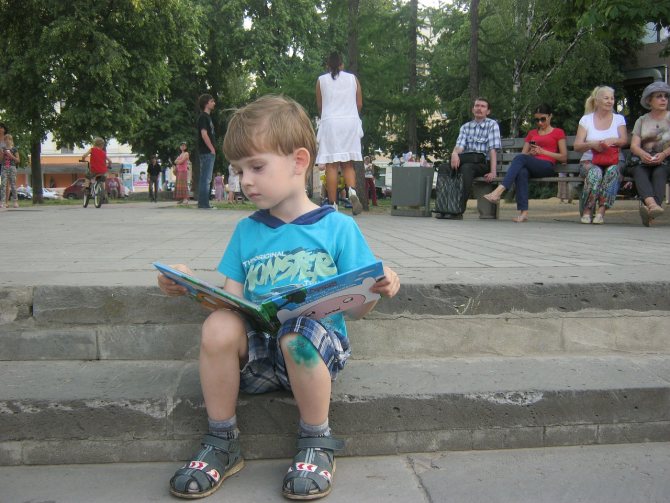
Books help children explore and understand the world around them
The objectives of a specific lesson may be:
- introducing children to literary works, meeting new writers;
- replenishment of vocabulary, familiarization with new words;
- developing the skill of expressive reading and intonation;
- expanding knowledge about the world around us (for example, getting to know professions while studying S. Mikhalkov’s poem “What do you have?”).
Reading list on the topic “winter”
- N. Sladkov “The Trial of December”
- V. Odoevsky “Moroz Ivanovich”
- S. Ivanov “What kind of snow happens”
- E. Trutneva “First Snow”
- K. Balmont “Snowflake”
- G. Snegirev “About Birds”
- N Sladkov “Spruce porridge”
- V. Zotov “Klest”, “About Birds”
- V. Bianchi “Who flew to the feeding trough?” , “Titmouse Calendar”, “Young Crow”
- S. Marshak “Twelve months”
- Brother Grimm "Mistress Blizzard"
- Riddles about winter phenomena in nature
- Proverbs and sayings about winter.
Proverbs and sayings about winter
- How winter is not angry, but submits to spring.
- Winter without snow is summer without bread.
- The year ends and winter begins.
- The bullfinch will fly in and announce winter.
- There are frosts in winter and thunderstorms in summer.
- Winter is not summer, she’s wearing a fur coat.
- Winter begins with frosts and ends in drops.
- Two friends - frost and blizzard.
- Winter scares summer, but it still melts.
- The New Year will lead to spring: it begins the year and marks the middle of winter.
- The stronger the winter, the sooner spring.
- The snow is deep - the year is good.
- There is also such a year that there are seven weather conditions per day.
- Winter will ask what your summer brings.
- Autumn is rich in bread, and winter is rich in snow.
- Winter day - sparrow hop.
- On New Year's Day the day was increased by a rabbit's leap.
- Prepare a cart in winter and a sleigh in summer.
- Take care of your nose in the extreme cold.
- The frost is not great, but it is not good to stand.
Folklore of the peoples of the world
Songs. “The Ship”, “The Brave Men”, “Little Fairies”, “The Three Trappers” English, arr. S. Marshak; “What a rumble”, trans. from Latvian S. Marshak; “Buy a bow.”, trans. with scotch N. Tokmakova; “Conversation of Frogs”, “Uncooperative Hoopoe”, “Help!” lane from Czech S. Marshak.
Fairy tales. “Mitten”, “Goat-dereza” in Ukrainian, arr. E. Blaginina; “Two Greedy Little Bears”, Hungarian, arr. A. Krasnova and V. Vazhdaeva; “Stubborn goats”, Uzbek, arr. Sh. Sagdully; “Visiting the Sun”, translated from Slovak. S. Mogilevskaya and L. Zorina; "Nanny Fox", trans. from Finnish E. Soini; “The Brave Well Done”, trans. from Bulgarian L. Gribova; “Pykh”, Belarusian, arr. N. Myalika; “The forest bear and the naughty mouse”, Latvian, arr. Y. Vanaga, per. L. Voronkova; "The Rooster and the Fox", trans. with scotch M, Klyagina-Kondratieva; "The Pig and the Kite", a fairy tale of the peoples of Mozambique, trans. from Portugal Yu. Chubkova.
Methodology for introducing preschoolers to literary works
Why is reading to children so important in kindergarten? Junior group 2 is the time when psychologists recommend developing imaginative thinking. To make the book that the teacher reads interesting for children, you can use role-playing games and puppet theater.
While reading a book, the teacher changes the intonation, emphasizing the positive and negative traits of the hero, highlighting certain storylines. A mandatory element after reading a work is its discussion. The teacher asks the children questions, by answering which the children develop their speech skills. They not only learn to express their thoughts, but also develop communication skills.
How to turn reading the fairy tale “The Gingerbread House” into a real performance? 2 younger group can take an active part in “revitalizing” this work. With the help of facial expressions, movements, armed with soft toys, children can “read” this work together with the teacher.
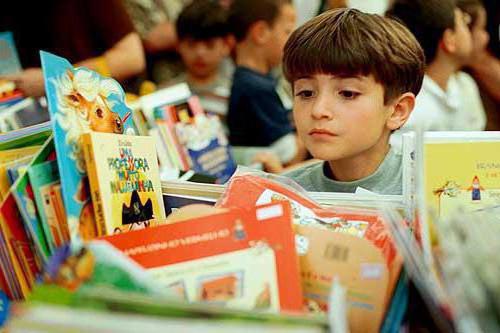
Works of poets and writers from different countries
Poetry. E. Vieru. "The Hedgehog and the Drum", trans. with mold. Y. Akima; P. Voronko. "The Sly Hedgehog", trans. from Ukrainian S. Marshak; L. Mileva. "Swift Legs and Gray Clothes", trans. from Bulgarian M. Marinova; A. Milne. "Three Little Foxes", trans. from English N. Slepakova; N. Scored. "Pencil", trans. from Ukrainian 3. Alexandrova; S. Kapugikyan. “Who will finish drinking sooner”, “Masha does not cry” trans. from Armenian T. Spendiarova; A. Bosev. "Rain", trans. from Bulgarian I. Maznina; “The Finch Sings”, trans. from Bulgarian I. Tokmakova; M. Karem. "My cat", trans. from French M. Kudinova.
Prose. D. Bisset. “The Frog in the Mirror”, translation, from English. N. Shereshevskaya; L. Muur. "Little Raccoon and the One Who Sits in the Pond", trans. from English O. Obraztsova; Ch. Yancharsky. “Games”, “Scooter” (from the book “The Adventures of Mishka Ushastik”, translated from Polish by V. Prikhodko; E. Bekhlerova. “Cabbage Leaf”, translated from Polish by G. Lukin; A. Bosev. “Three” , translated from Bulgarian by V. Viktorova; B. Potter. “Ukhti-Tukhti”, translated from English by O. Obraztsova; J. Capek. “A Hard Day”, “Into the Forest”, “Yarinka’s Doll” (from the book "The Adventures of a Dog and a Cat", translated by Czech G. Lukin; O. Alfaro. "The Goat Hero", translated from Spanish by T. Davityants; O. Panku-Yash. "Good night, Dooku!", translated . from the Romanians by M. Olsufieva, “Not only in kindergarten” (abbr., translated from the Romanians by T. Ivanova.
